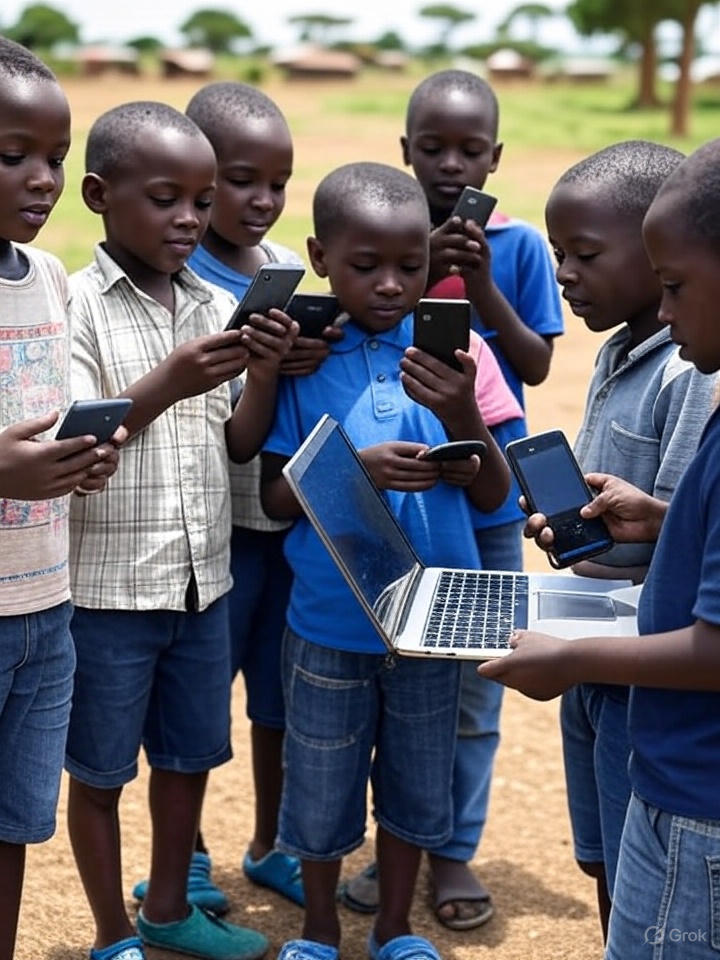
Children (0-17) form 31.6% of the population engaging with digital media, particularly in urban areas like Thika, where Action for Children in Conflict (AfCiC) operates. The majority of the children have confirmed to use digital media for e-learning, gaming, and watching videos. This access, however, when left unsupervised, negatively impacts the overall wellbeing of the children.
Emerging Concerns in Children Consuming Digital Media
Delayed Language and Communication Skills
Children who spend excessive time on the screen tend to have delayed language development. This is a result of one-way communication between the children and the content they consume on the screens. In ideal setups, children are bound to engage in interactive two-way communications with their peers and parents, which in return, fosters their language development.
Increased Anti-social Behaviors
Children create emotional connections while playing and interacting with others. But children who spend most of their time on the screens forego the opportunity to foster meaningful relationships with others. This has resulted in many children forming emotional intelligence that is below average.
Reduced Attention
Due to constant stimulation of the mind through fast-paced videos, color, and graphics, children's brain development is greatly affected. Tasks that require uninterrupted attention, such as reading slowly, solving problems, become a challenge. The attention deficit is also evident in scenarios where instructions or approaches are given to these children.
Mental Issues such as depression
As a result of overconsumption of digital media, children have been exposed to disturbing content online. This type of content often leads to anxiety and mental disorders among children, with the worst cases of suicidal thoughts reported. These issues are further exacerbated in cases where online child predators are involved.
The pervasive impact of digital media on Kenyan children, with 30–40% engaging daily and 35% of adolescents spending over 6 hours on platforms, often unsupervised, underscores the urgent need for protective measures in areas like Thika.
The Time to Play Project
The Time to Play project, implemented by Action for Children in Conflict in partnership with Terre des Hommes Netherlands, aims to promote inclusive, safe play spaces for children within Thika, Kenya. The main goal of the project is to ensure that, through play, children are protected from abuse and exploitation.
Through this programming, the Time to Play project has played a crucial role in safeguarding children from the negative impacts of digital media. By advocating for real-time and physical play, the project has ensured reduced screen time among children.
Among the project activities, which include creative activities such as drawing, singing, and writing poems, young children have been able to freely articulate their thoughts and exchange ideas among themselves. This has fostered communication skills and language development.
“This project has played a key role in enhancing the holistic development of the children engaged within the project. We have seen children protected from exploitation, which includes online exploitation. Also, through Child Rights Clubs, children are now able to interact and socialize, which has contributed to improved communication skills,” James Mugambi, Time to Play project officer.
Impact
The Time to Play project has directly engaged more than 1,154 children through leisure reading activities, child rights clubs on holidays, and through creative activities such as art and drawing. The project has further engaged parents and trained them in positive parenting, highlighting the need for regulation among children consuming digital media.
Additionally, the project has incorporated digital literacy training sessions into life skills education through the use of electronic gadgets, videos, images, and graphics. These literacy sessions further emphasize the need for responsible use of digital media among children.
Conclusion
Despite these key interventions, there is still a need for children to be protected from the negative impacts of Digital Media. More and more children are left unsupervised as they consume digital media either due to busy working parents, peer pressure, and/or through access from their peers.
The alarmingly rising numbers call for urgent action among all players in the child protection sector.
Through our Time to Play project, it is evident that play is crucial for the healthy development of children. Together we can join hands to create safer play spaces for all our children to thrive in.
Support by donating here: Donate Here
Article
by Peter Mwaura, Communications Lead, Action for Children in Conflict
Whether you have skills to share, resources to offer, or simply a passion for helping others, your involvement is priceless. Together, we can amplify our impact, Your donation will enable us rescue more children from the streets, rehabilitate them at our Temporary Rescue Centre where they are provided basic needs and are finally reintegrated into the society. . Take the first step—fill out our volunteer form today! Let’s work together to create lasting change in our communities.